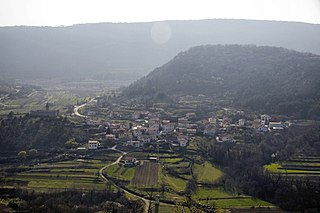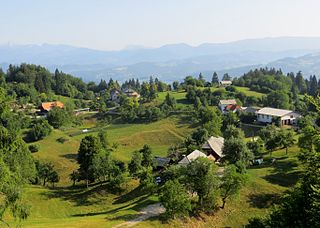
Cerknica is a town in the Karst region of southwestern Slovenia, with a population of 4,018. It is the seat of the Municipality of Cerknica. It belongs to the traditional region of Inner Carniola.

Vuzenica is a town and a municipality in northern Slovenia. It lies on the right bank of the Drava River and extends south into the Pohorje Hills. The area was part of the traditional region of Styria. It is now included in the Carinthia Statistical Region. Vuzenica was first mentioned as a settlement in written documents dating to 1238, but archaeological evidence points to much older settlement of the area with a Roman period burial ground in the town. Of the 13th-century castle above the settlement, only parts of the walls survive.

Štanjel is a village in the Municipality of Komen in the Littoral region of Slovenia. It is located on the Karst Plateau overlooking the Vipava Valley. In the 17th century it was fortified to defend it against Ottoman raids. It was heavily damaged during World War II and it has been slowly rebuilt since.

Ljubljana Cathedral, officially named St. Nicholas's Church, also named St. Nicholas' Cathedral, the Cathedral of St. Nicholas, or simply the Cathedral, is a cathedral in Ljubljana, the capital of Slovenia. Originally, Ljubljana Cathedral was a Gothic church. In the early 18th century, it was replaced by a Baroque building. It is an easily recognizable landmark of the city with its green dome and twin towers and stands at Cyril and Methodius Square by the nearby Ljubljana Central Market and Town Hall.

Hrastovlje is a village in the City Municipality of Koper in the Littoral region of Slovenia.

Limbuš is a village on the right bank of the Drava River west of Maribor in northeastern Slovenia. It belongs to the City Municipality of Maribor.

Velike Brusnice is a settlement at the foothills of the Gorjanci range to the east of Novo Mesto in southeastern Slovenia. The entire municipality of Novo Mesto is part of the traditional region of Lower Carniola and is now included in the Southeast Slovenia Statistical Region.

St. Mark's Church is a small church on the outskirts of the village of Vrba in Upper Carniola in Slovenia. Though it is a small and simple church, it has achieved near mythical status in Slovenia, after it was mentioned in the sonnet O Vrba by Slovene national poet France Prešeren. Though it is only mentioned in the last verse of this single sonnet, it has come to symbolise homeliness and safety to which one can turn when bitterness and disappointment over having followed one's destiny to foreign lands becomes too much to bear. In January 2011, it was proclaimed cultural monument of national importance by the Government of Slovenia.

Crngrob is a small village in the Municipality of Škofja Loka in the Upper Carniola region of Slovenia.

Setnik is a dispersed settlement east of Polhov Gradec in the Municipality of Dobrova–Polhov Gradec in the Upper Carniola region of Slovenia. It includes the hamlets of Zalog, Butajnova, Veliki Vrh, and Mali Vrh. Setnik is known as Setjək in the local dialect.

Holy Trinity Church is a historical building in Hrastovlje, a village in southwestern Slovenia. There are two hypotheses about its origin. According to the first, it is a Romanesque church from the 12th century. According to the second, it is an example of the Istrian variant of Early Venetian Renaissance architecture from the 15th century. The church stands behind a wall that the local population built to protect itself from Turkish attacks in the 16th century. Such defensive architectures are found throughout the territory settled by Slovenians and are called tabor.

Leskovec pri Krškem is a settlement on the right bank of the Sava River in the Municipality of Krško in eastern Slovenia. The area was traditionally part of Lower Carniola. It is now included with the rest of the municipality in the Lower Sava Statistical Region. It includes the hamlets of Grad, Beli Breg, Veliki Marof, and Žadovinka. Older sources also mention the appertaining hamlet of Bajer.

Groblje pri Prekopi is a settlement northeast of Šentjernej in southeastern Slovenia. The area was traditionally part of Lower Carniola. It is now included in the Southeast Slovenia Statistical Region.

Rosalnice is a village on the left bank of the Kolpa River, east of the town of Metlika in the White Carniola area of southeastern Slovenia, right on the border with Croatia. The railway line from Novo Mesto to Karlovac runs through the settlement before it crosses the Kolpa River into Croatia. The entire area is part of the traditional region of Lower Carniola and is now included in the Southeast Slovenia Statistical Region.

Rajhenav is an abandoned settlement in the Municipality of Kočevje in southern Slovenia. The area is part of the traditional region of Lower Carniola and is now included in the Southeast Slovenia Statistical Region.

Katarija is a settlement in the hills south of Moravče in central Slovenia. Traditionally the area was part of Upper Carniola. It is now included with the rest of the Municipality of Moravče in the Central Slovenia Statistical Region. In addition to the main settlement, it includes the hamlets of Vrh Svetega Miklavža and Grmače.

Črešnjice is a settlement in the Municipality of Vojnik in eastern Slovenia. The area was traditionally part of the Styria region. It is now included with the rest of the municipality in the Savinja Statistical Region.

Dobrava is a nucleated village in the Municipality of Trebnje in eastern Slovenia. It lies on the southern edge of the municipality, northeast of Žužemberk. The area is part of the historical Lower Carniola region. The municipality is now included in the Southeast Slovenia Statistical Region.

Rudnik is a former village, now included in the southern part of Ljubljana, the capital of Slovenia. It was part of the district of Lower Carniola.

Zavoglje is a formerly independent settlement in the eastern part of the capital Ljubljana in central Slovenia. It lies at the confluence of the Ljubljanica River with Dobrunjščica Creek. It was part of the traditional region of Lower Carniola and is now included with the rest of the municipality in the Central Slovenia Statistical Region. In addition to the main settlement, Zavoglje includes the hamlet of Mrakovce.
























